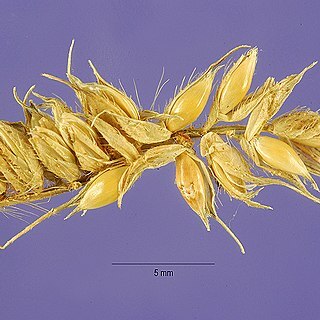Perennial; rarely annual; 0.8-1.5 m high; hydrophyte; rhizomatous; and stoloniferous. Leaf blades 100-450 x 4-15 mm; ligule a fringe of hairs; often absent in upper leaves. Flowers: inflorescence open; 80-250 mm long; racemes 20-80 mm long; branches clearly secund; spikelets 4-6 x 1.0-1.8 mm; excluding awn; narrowly ovate; with rigid hairs on nerves; lower floret male or sterile; lower lemma with awns (1-)3-20(-50) mm long.
An annual swamp grass. It grows 1-2 m high. It has long creeping rhizomes. It can lie over and form roots at the nodes. The leaf blade is 8-50 cm long by 6-10 mm wide. The flower arrangement is a narrow sword shape. It is 7-20 cm long.


